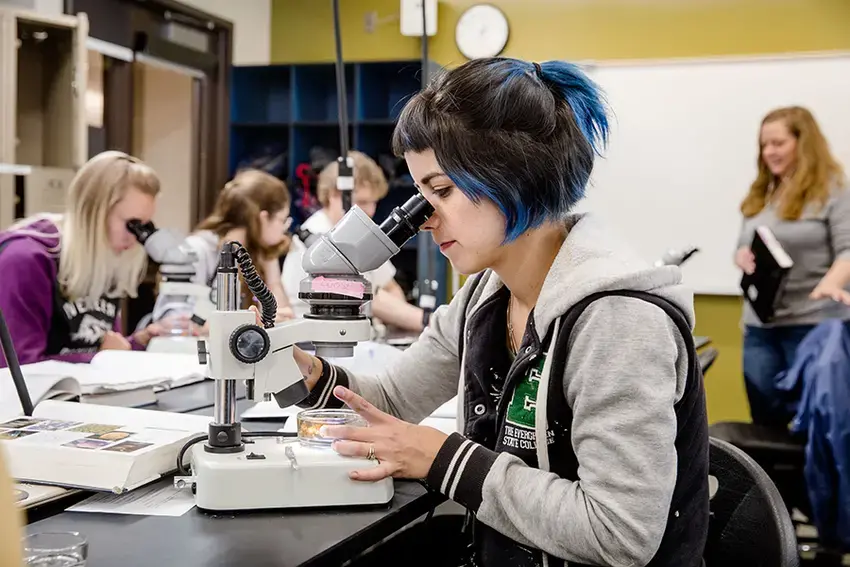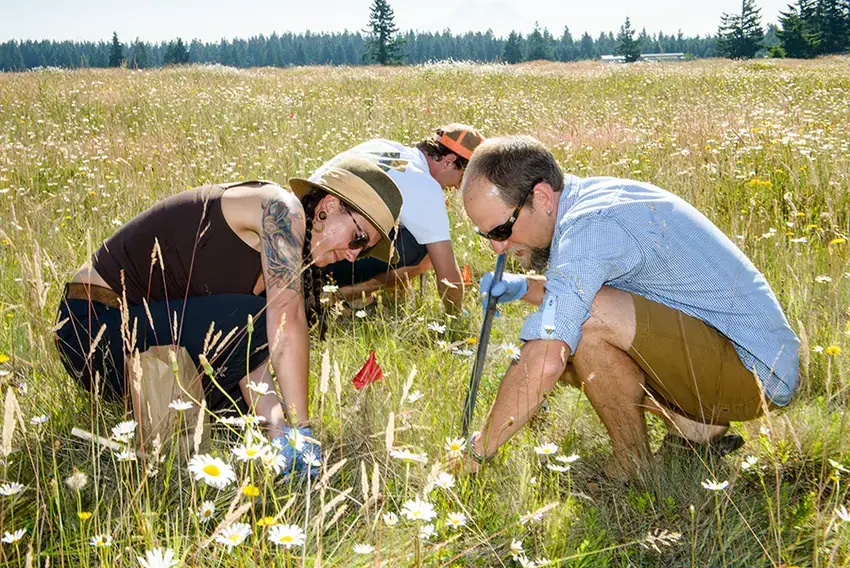
Teaching Labs
Evergreen has dedicated laboratories designed specifically for instruction and research in multiple disciplines, both in the classroom and in the field.
Our lab buildings house a state-of-the-art organic chemistry lab, a high-tech water quality analysis lab, an environmental analysis lab, two modern biochemistry and molecular biology labs, several general chemistry and biology labs, general and advanced physics labs, microscopy labs, a sustainable agriculture and food lab, a geology lab and a marine science lab with multiple saltwater aquaria.
Advanced Instrumentation and Microscopy
Students can earn operating licenses to independently run major instrumentation on campus for chemical detection and analysis, soil and water quality characterization and advanced microscopy.
Instrumentation
Scientific Instrumentation
Are you interested in learning to use the instrumentation? Evergreen provides training so that you may independently operate the advanced instrumentation.
Atomic Absorption Spectrometer (AAS)
The AAS is used for qualitative and quantitative elemental analysis, examining a single element at a time.
Sample Types: water, soil, minerals, airborne particulates and biological materials
Detection Limit: ~0.2 – 10 ppm depending on analyte
Inductively Coupled Plasma – Mass Spectrometer (ICP-MS)
The ICP-MS is used for qualitative and quantitative multi-elemental analysis at trace-level concentrations.
Sample Types: water, soil, minerals, airborne particulates and biological materials
Detection Limit: ~ppt (parts per trillion)
Mercury Analyzer
The mercury analyzer is used for qualitative and quantitative determination of total mercury in a sample.
Sample Types: water, soil, minerals, airborne particulates and biological materials
Detection Limit: ~0.002 ng
Carbon, Hydrogen, Nitrogen Analyzer (C, H, N)
The CHN analyzer is used for qualitative and quantitative analysis of the carbon, hydrogen, and nitrogen content in samples. All three elements are analyzed simultaneously.
Sample types: soil; water, and biological materials
Detection Limit: ~ .001 mgs
Discrete Analyzer
The discrete analyzer is used for quantitative and qualitative analysis of anions and cations commonly used to indicate water and soil quality. It can detect various forms of nitrogen and phosphorus, as well as alkalinity and silica, although it is limited in the number of separate analytes it can measure at one time.
Sample Types: water, soil, and biological materials
Detection Limit: ~0.06-0.2 ppm depending on analyte
Ion Chromatograph (IC)
The IC is used for qualitative and quantitative analysis of anions, such as fluoride, chloride, nitrite, nitrate, sulfate, and phosphate. It can analyze multiple analytes in a single sample run.
Sample types: fresh water (no brackish or saltwater), water-extracted soil, and water-extracted airborne particulates
Detection Limit: ~0.2 ppm
Polarograph
The polarograph is used for qualitative and quantitative analysis of anions and cations, forfunctional groups in organic compounds, and for many different elements. It can also be used to measure redox conditions. It can measure only a single analyte at a time.
Sample types: water, soil, airborne particulates, and biological materials
Detection Limit: ~ppb depending on analyte
Fourier Transform Nuclear Magnetic Resonance Spectrometer (FT-NMR)
The FT-NMR is used to for qualitative and quantitative analysis of organic compounds, and is most commonly used to determine the carbon-hydrogen framework of organic molecules. Available analysis includes 13C, 1H, 31P, and 19F.
Sample Types: organic compounds
Detection limit: ~µM
Gas Chromatograph Mass Spectrometer (GC-MS)
The GC-MS is used for qualitative and quantitative analysis of organic compounds. It can separate components of a mixture and provide information about the chemical structures of compounds.
Sample types: organic liquids, gases, soil, water, and biological materials
Detection limits: ~ ppb
Fourier Transform Infrared Spectrometer (FT-IR)
The FT-IR is used for qualitative and quantitative analysis of organic and inorganic compounds and is most commonly used to identify functional groups within a compound.
Sample types: organic and inorganic compounds.
Microscopes
Advanced Steromicroscopes
The advanced stereomicroscopes are suitable for life science and materials research. These microscopes use high-resolution color cameras, computer-controlled motorized focus, and image-processing software to provide expanded focal imaging (or Z-stacking) capability and advanced image analysis. The scopes are equipped with multiple illumination sources and imaging modes including: transmitted, ring light, relief-contrast, darkfield, side light, and epi-fluorescence.
Sample Types: Best suited for samples that are too large or opaque for a compound microscope. Can be used with wet or dry samples.
Magnification: 5-320X (not all illumination techniques available at maximum magnification)
Advanced Upright Compound Microscope
This advanced upright compound microscope is suitable for life science research. It is equipped with high resolution optics and is set up for several imaging methods including: brightfield, phase contrast, differential interference contrast, dark field, and epi-fluorescence. It is equipped with a high-resolution dual sensor camera and software, allowing for both color and high-sensitivity data collection. This microscope also has expanded focal imaging (or Z-stacking) capability.
Sample types: Best suited for slide-mounted samples or microtome-sectioned tissue
Magnification: 40-1000X
Advanced Inverted Compound Microscope/Confocal
This advanced inverted compound microscope is suitable for life science research. It is equipped with high resolution optics and is set up for several imaging methods including: brightfield, differential interference contrast, epi-fluorescence, and confocal fluorescence. It is equipped with a high-resolution camera and software, allowing for high sensitivity data collection and expanded focal imaging (or Z-stacking) capability.
Sample types: Cell culture flasks, specimen dishes, deep well slides/plates, and slide-mounted samples.
Magnification: 40-1200X
Scanning Electron Microscope (SEM)
The SEM is an electron microscope that provides morphological, topographical, and compositional information about the surface of the specimen. The SEM has both backscatter and secondary electron detectors and can run in low and high vacuum modes.
Sample types: Fixed, dried, and coated samples
Magnification: 8-300,000X
Science Support Center
The Center is the hub for all science operations at Evergreen. It’s home to a vast array of equipment and supplies, whether for lab work or independent research. Our science support staff are friendly, helpful and knowledgeable.
Visit the Center's lounge to study, eat lunch and hang out with fellow science students!

Outdoor Living Laboratories
Evergreen's campus sits on 1,000-acres of forest and hosts an established ecological monitoring network, a 5-acre organic farm, and community, ethnobotanical and medicinal gardens.
The Evergreen Ecological Observation Network tracks many measures of forest function and health at 44 plots distributed within the forest reserve. More than a half-mile of beach is a shoreline reserve on the Salish Sea, with both extensive wildlife habitat and a shellfish garden managed by the student-run Shellfish Club.
Learn more about Evergreen's forest, trails and beach.
Evergreen Science Boats
For access to marine systems outside the tidal zone, Evergreen owns a fleet of small power and row boats. These are used by academic programs and are also available for research activities by Evergreen students, faculty and staff. Students can receive training to allow them independent use of the boats for research within the South Puget Sound and beyond.
For more information about boats and boat check-out, contact sit@evergreen.edu.

Organic Farm
Evergreen's Organic Farm is a working small-scale USDA-certified organic farm and a learning laboratory for students.
Sustainable Agriculture Lab
This lab space is for developing a scientific, cultural and sensory understanding of our food systems. The facility is equipped for hands-on cooking and lab activities, value-added food production, lectures and social gatherings.
Independent and Faculty-Sponsored Research
Students may pursue independent research projects with faculty support. There are many ways to study independently at Evergreen, this is a great way to dig deep into your passions.
Many faculty maintain active research programs in both lab and field sciences. Evergreen students are frequently co-authors on published scientific journal articles, and present at local, national and international conferences. Areas of ongoing research include:
- Bryophyte and lichen diversity
- Molecular biology
- Ecosystem ecology
- Freshwater ecology
- Organic chemistry
- Ornithology
- Marine science
Interested in participating in faculty-sponsored research? Speak to your faculty about specific opportunities and check out our Summer Undergraduate Research Fellowships.